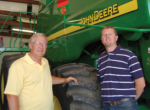Advertise Follow Us
Items Tagged with 'Covers'
ARTICLES
Saving The Soil ‘Skin,’ Thriving With No-Till
What began as an economic decision has morphed into a successful and profitable livestock and cropping operation for longtime South Dakota no-tiller Rick Bieber.
Read More
Precision, Covers, Planter Tweaks Piece Together No-Till Success
Ohio no-tillers Steve and Doug Longfellow are saving inputs, improving soils and hiking yields on their heavy clay fields by building a complete no-till system.
Read More
Fertility, Covers, Precision Inputs Form Complete No-Till Package
Bill Murr leverages the soil-building benefits of no-till with strategic nutrient, weed and disease management on his 3,400-acre farm in northeast Kansas.
Read More
Choosing Covers To Maximize Your No-Till Nitrogen Payback
Cover crops can prevent nitrogen losses during winter fallow, but no-tillers should be mindful of how carbon-to-nitrogen ratios in residue affects what’s available for the next crop.
Read More
Rolling, Crimping Can Help No-Tillers Use Covers Better
Well-designed roller-crimpers, and a good management plan, can help no-tillers and strip-tillers smother weeds, improve soil protection and get the most from high-biomass cover crops.
Read More












